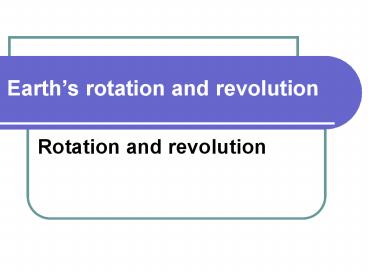Earths rotation and revolution - PowerPoint PPT Presentation
1 / 19
Title:
Earths rotation and revolution
Description:
In 1878, Canadian Sir Sanford Fleming suggested a system of worldwide time zones. ... in Canada and the United States began using Fleming's time zones in 1883. ... – PowerPoint PPT presentation
Number of Views:3899
Avg rating:3.0/5.0
Title: Earths rotation and revolution
1
Earths rotation and revolution
- Rotation and revolution
2
The earths rotation and time
- The earth undergoes one complete rotation along
its axis in 24 hours. - For one complete rotation, the earth passes
through 360 degrees of longitude. - For every one-hour time, a point on the earth
moves through 15 degrees of longitude (360/24
hours 15o). - For every 4 minutes, a point on the earth passes
through 1 degree of longitude
3
Earths rotation and time
- The earth rotates in an anti-clockwise direction
(From West to East). - Places on the East side of a given point on the
earth are ahead of time while those to the West
side of the same point always lag behind in time.
- The most important result of the earth's rotation
is the daily pattern of DAYS and NIGHTS
4
Longitude and Time
5
Coordinated Universal Time
6
Standard Time in North America
- In 1878, Canadian Sir Sanford Fleming suggested a
system of worldwide time zones. - Fleming proposed that the globe be divided into
24 time zones, each 15 degrees of longitude in
width. - Railroad companies in Canada and the United
States began using Fleming's time zones in 1883. - In 1884, an International Prime Meridian
Conference in Washington D.C. accepted it.
7
Time Zones in North America
- Mainland US is divided into 4 Time Zones
- Eastern Time Zone New York, Boston
- Central Time Zone - Chicago
- Mountain Time Zone Denver
- Pacific Time Zone Los Angeles
8
International date line
- Each new calendar day begins at midnight on the
International Date Line (Longitude 180o). - Crossing the date line causes adjustments to
clocks dates. - Traveling from West toward East (Hawaii to Japan)
one jumps into a new day on crossing the Date
line. - From East towards West (Japan to Hawaii), one
looses a day after crossing the line
9
Environmental Effects of Rotation
- The Imposition of Day/Night rhythm
- The redirection of the flow paths of both air and
water that flows over the earths surface. - Flows in the Northern Hemisphere Right
- Flows in the Southern Hemisphere - Left
- Rise and fall in Tidal Waves over the oceans.
10
Earths revolution round the Sun
- The earth revolves around the Sun on its own
ORBIT (oval-shaped path). - Perihelion A point on the orbit where the earth
is closest to the sun - January 3rd - Aphelion A point where the sun is farthest away
from the SUN - July 4th. - On its orbit round the sun, the earth moves
through a plane called the PLANE OF THE ECLIPTIC.
11
Earths inclination and the Seasons
12
Earths revolution
- The earth's axis is inclined to the orbit at an
angle of 23.50 - Inclination of the earths axis during the
movement round the Sun results in the following - 1. different positions of the noon Sun
- 2. different positions of Sun rise and sun set
- 3. different length of days nights in a year
- 4. different shadow lengths during the seasons
13
Results of the resolution Equinoxes
- March 21 is Spring Equinox and
- September 21 is Autumnal Equinox.
- On these days, the noon Sun is points directly on
the equator so - ALL PLACES on the earths surface receive
approximately 12 hours of daylight and 12 hours
of darkness.
14
Images of the four seasons
1. Summer
2. Fall (Autumn)
3. Spring
4. Winter
15
Results of the revolutionSummer solstice
- June 21st (Summer Solstice)
- Places in the Arctic circle points directly
toward the sun so the Northern Hemisphere receive
more sunlight (hence longer days and shorter
nights) - On this day, places in the Southern Hemisphere
receive less sunlight (so shorter days and longer
nights).
16
Northern Hemisphere during the Summer Solstice
- In summer the earths axis lean toward the sun so
the energy we receive from the sun is more direct - The sun also remains in the sky for longer
periods and as such the earths surface absorbs
more solar energy - The high temperatures produce summer conditions.
17
Winter solstice
- December 21st (Winter Solstice)
- On this day, the Sun moves into the Southern
Hemisphere and places there receive more sunlight
and experience longer days and shorter nights. - The Northern hemisphere receive less sunlight (so
shorter days and longer nights).
18
Northern Hemisphere during the Winter Solstice
- Because the earths axis point to the same
direction toward the North Star, the Northern
hemisphere leans back on the Sun during winter - The Sun is lower in the sky and its energy is
more widely distributed - The Sun is also visible for a much shorter time
giving off little energy so temperature goes down
producing winter conditions
19
Summer and Winter Seasons
NORTHERN SUMMER
NORTHERN WINTER

